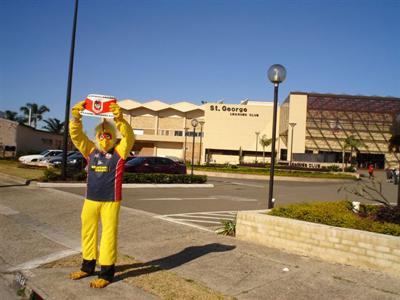Rational Trigonometry
A number of news outlets are reporting that an Australian professor has just rewritten the laws of trigonometry. Rather than using tools designed for circles, he uses squares and “spread”. Apparently the current system of trigonomtry is error prone, which doesn’t suprise me, but I’ve always been fascinated about what we (as a society and schools) would do if there was a major change in the way we carry out mathematical procedures. I’ve always felt that there was a time when we were very open to change in Science, Maths and English, but lately I feel we have become stubborn and these rules which may or may not be correct are bound into some kind of inflicted concrete. Perhaps it is just that there haven’t really been any major theoretical changes in my lifetime, sure computers have entered mainstream use, but it never seemed like a difficult thing to implement into classrooms, it happened gradually, helped in some ways by computer companies like Apple giving computers to schools for their own purposes, and in effect helping to bring a new generation into a new world.
Allow me to deviate slightly. Apple were very generous, particularly in parts of Australia where they gave schools a bunch of Apple Macintosh computers. Apple believed that students growing up with, and learning to use, Macintosh computers would grow up and continue to use Apple Macintosh. Although this wasn’t entirely unreasonable thinking, it wasn’t exactly correct. Microsoft, who Apple contracted to help write the first version of Macintosh (incredibly buggy by the way), then went and wrote Windows based on similar code for a different architecture. IBM and Microsoft had a bit of a partnership going with Windows and OS/2, however Microsoft did some evil things to IBM and released Windows 95, based quite firmly on OS/2 code, whilst retaining backward compatibility with older versions of Windows. Windows 3.11 (and previous) applications were able to run on OS/2, but Microsoft weasled out of their obligations with IBM and manged to give them a solid push into a downward spiral. By locking OS/2 out of running Windows 95 applications, they effectively drove nails into the coffin of a very good Operating System. Windows 95 was also the first Windows to look like Macintosh, and with the combination of code from Mac and OS/2, Microsoft obviously thought they had won the war, unfortunately (or fortunately I suppose) they were in such a rush that they botched the OS and left it filled with bugs and security issues that they have never been able to fix. The current incarnation of Windows continues the line of work that started with these rushed combinations, and it has become quite apparent that the people at Microsoft really don’t know how to write a decent Kernel or Operating System. It may be dominant, but it is far from perfect, and fixing it would break all the existing Windows applications, so they can’t do that…catch 22.
Anyway, back to Trigonometry and educational change. It seems that teachers and textbooks all rely on the existing rules, and even simplifactions and clarifications to these rules take time to be implemented. Apparently the new rules of trigonometry will make calculations easier and more accurate, so I do hope that they are understood and implemented soon. Due to the inherently simpler nature of the newer rules, I wouldn’t expect much retraining will be required for people who use and teach the existing rules, the thing that will take time, however, will be the implementation of the new rules in people’s heads.
After a while, the notion of how to utilise trigonometry becomes second nature, and that is the tricky bit. Whilst you can learn a new way to do something, it is not always easy to actually do it the new way when it comes to the time that you need to do it. In fact, that takes a lot longer, and that is what will slow down the implementation of the new rules.
The same thing happened with the conversion from imperial meaurements to metric measurements. People still talk in yards, pounds and inches because those are the measurements that are second nature to them. Mind you, I think there would be greater resistance to a measurement system change now than there was when we changed from imperial to metric, mainly due to that stubborness I mentioned earlier.
ABC Online explains the new Trigonometry pretty well:
The mathematical study of triangles has just got a whole lot simpler, according to a researcher who says his new theory of trigonometry is easier to use and more accurate.
Associate Professor Norman Wildberger, of the University of New South Wales in Sydney, Australia, says his theory of “rational trigonometry” is more like algebra as you can plug numbers into an equation and get an accurate result.
“We’re going to look at trigonometry in a new way,” says Wildberger.
“We’re going to leave sines and cosines to the circular motion part of mathematics and not force it on triangles.”
Wildberger says the trigonometry we know and love (or hate) today has its historical roots in the work of ancient astronomers, like Ptolemy, who studied the motion of planets.
In this case, the angle between two points in the sky, as seen from Earth, was a reasonable way of calculating the distance between them, he says.
But, says Wildberger, the problem came when others applied these theories, developed for spherical geometry, to the study of flat triangles.
“It’s all very well to do if you’re working on a sphere or a circle but when we actually study triangles there aren’t any circles there,” he says.
New concepts
The key purpose of trigonometry is to understand the relationships between the corners and sides of triangles.
It is used in areas like surveying, engineering and construction today.
Classical trigonometry calls the separation between two lines an “angle”, which is the length of a circular arc between two lines.
An angle can be calculated using an equation that relates the corners of a triangle (using the concepts of sine, cosine or tangent) to the length (distance) of the side opposite it.
But Wildberger says that distance is not the best way to measure the separation of two points and angle is not the best way to measure the separation of two lines.
“It’s not the concept that leads to a mathematics that is the most pleasant and the most useful and the most accurate,” he says.
Instead of distance, Wildberger’s trigonometry uses a concept called “quandrance”, the square of distance.
Instead of angle, he uses the concept of “spread”, calculated by dividing one quadrance by another.
The spread between two lines is a number between 0 (representing parallel lines) and 1 (representing lines at right angles).
Wildberger says it would be possible to make a new protractor that measures spread instead of angle.
You would then plug the values for the quadrance and spread into his set of equations.
More accurate
What’s better about the system, says Wildberger, is that all the terms in the equations can be calculated exactly, or are “rational”, hence the term for his new theory, “rational trigonometry”.
But sine, cosine and tangent, are usually only approximated, he says, making them “transcendental functions”.
This means that any complex calculation using classical trigonometry could result in a significant accumulation of errors.
Wildberger says he hopes that “rational trigonometry” will provide high school students with a simpler way of thinking about triangles that is both more accurate and easier to carry out.
And he says the improved accuracy will be important elsewhere such as in GPS surveying or when engineers design devices.
Wildberger says he developed the new theory while studying more complex maths.
“It wasn’t that I set out to do this. It was just a fluke, in a way, that I realised ‘Hey these ideas can change elementary trigonometry’.”
Wildberger’s book, Divine Proportions: Rational Trigonometry to Universal Geometry, published by Wild Egg books, is launched this week.
Samuel
September 19th, 2005 at 09:09pm


